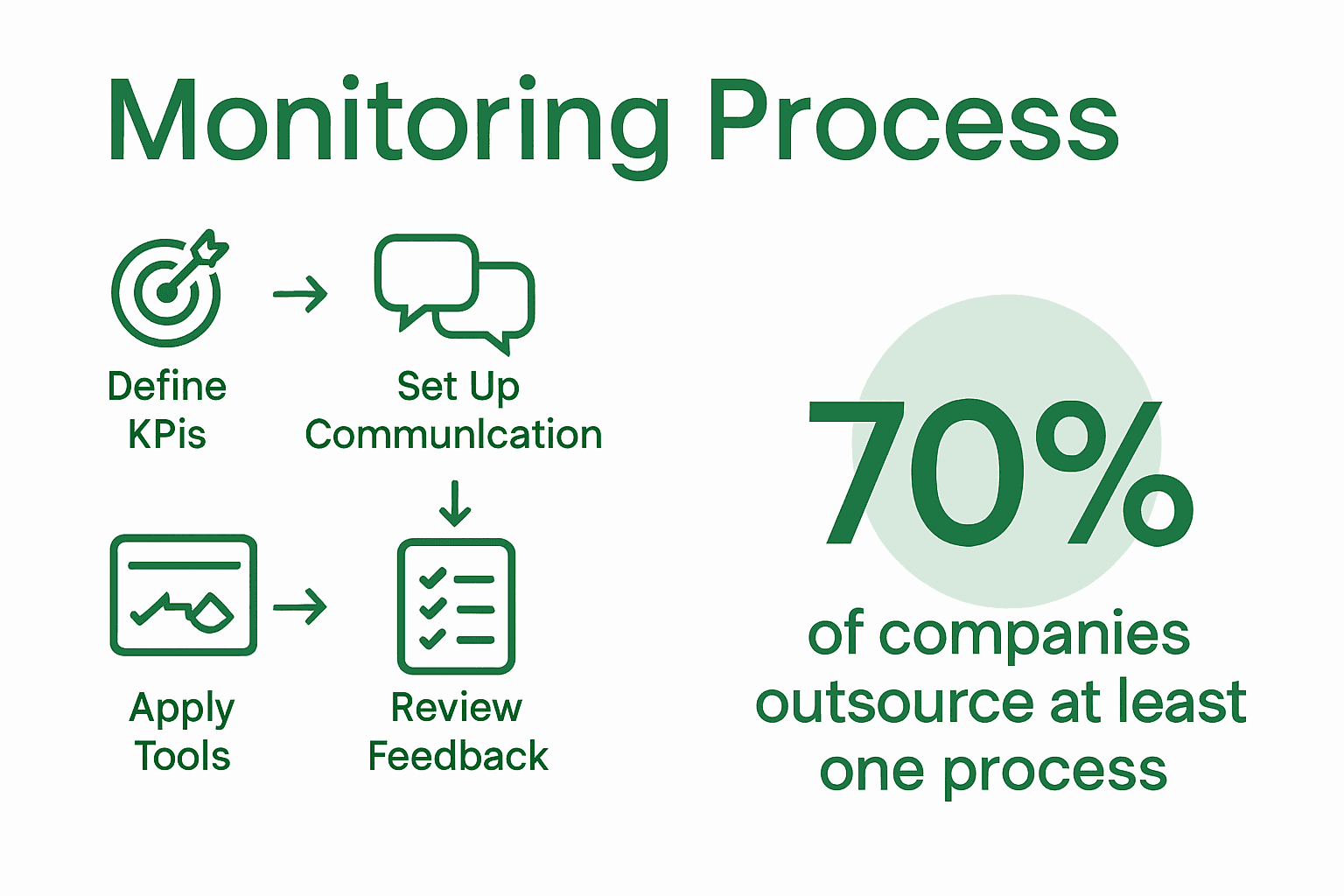Did you know that over 70 percent of companies worldwide now outsource at least one business process? Managing outsourced teams can save money and expand your talent pool, but it brings real challenges in tracking performance and maintaining accountability. Getting your monitoring framework right ensures every remote worker meets your standards and drives results for your business. This guide helps you create a robust approach so you can confidently measure and improve the effectiveness of your outsourced staff.
Step 1: Define monitoring objectives and KPIs
When outsourcing staff, setting clear monitoring objectives helps you track performance and ensure your external team delivers results. Your goal is to establish meaningful key performance indicators (KPIs) that align with your overall business strategy and provide actionable insights into your remote workforce’s effectiveness.
Start by identifying what matters most for your specific project or function. Are you focused on reducing production costs? Improving accuracy rates? Minimizing turnaround times? Each outsourced operation will have unique metrics. For example, a software development team might track coding efficiency and bug resolution speed, while a customer service team would monitor response times and customer satisfaction scores. The key is selecting metrics that give you a holistic view of performance.
Your KPIs should cover three critical areas: cost efficiency, operational reliability, and quality output. This balanced approach prevents you from getting tunnel vision on just one aspect of performance. A practical strategy is to break down your monitoring objectives into quantifiable targets.
 Instead of a vague goal like “improve performance,” set specific benchmarks such as “reduce processing time by 25%” or “maintain accuracy rates above 95%.” These precise measurements allow you to objectively evaluate your outsourced staff’s performance and make data driven decisions.
Instead of a vague goal like “improve performance,” set specific benchmarks such as “reduce processing time by 25%” or “maintain accuracy rates above 95%.” These precise measurements allow you to objectively evaluate your outsourced staff’s performance and make data driven decisions.
Pro Tip: Review and adjust your KPIs quarterly to ensure they remain relevant as your business evolves and project requirements change.
As you move forward, these clearly defined monitoring objectives will serve as your roadmap for managing and optimizing your outsourced team’s productivity.
Step 2: Set up reliable communication and reporting channels
Establishing robust communication channels is critical when managing outsourced staff. Your goal is to create a seamless information flow that keeps everyone aligned and promotes transparency across different teams and potentially multiple time zones.
Start by selecting collaborative platforms that support real time communication and project tracking. Tools like Slack and Microsoft Teams can bridge geographical distances and enable instant messaging. These platforms allow you to create dedicated channels for specific projects, share documents, and track conversations. Consider implementing a structured communication protocol that outlines expected response times, preferred communication methods for different scenarios, and clear escalation paths for urgent matters.
Regular scheduled meetings are equally important for maintaining team cohesion and tracking progress. Plan weekly video conferences where department heads and team leads can discuss current challenges, review performance metrics, and strategize solutions. During these meetings, use performance data to provide leadership with actionable insights. Make sure to record key discussion points and action items to maintain accountability and create a documentation trail.
Pro Tip: Establish a clear communication matrix that defines communication frequency, preferred channels, and expected response times for different types of interactions.
As you implement these communication strategies, you will create a transparent and efficient workflow that supports your outsourced team’s success and integration with your core business operations.

Step 3: Implement effective monitoring tools and platforms
Implementing the right monitoring tools is crucial for tracking your outsourced team’s performance and ensuring maximum productivity. Your objective is to select platforms that provide comprehensive insights into both operational efficiency and financial performance.
Begin by choosing software that offers robust tracking capabilities across multiple dimensions. Financial tools like Excel and QuickBooks can help you measure return on investment and analyze cost savings from outsourcing. Look for platforms that can capture direct and hidden costs providing a holistic view of your outsourcing arrangement. Additionally, consider project management tools that offer real time performance dashboards enabling you to monitor key metrics such as task completion rates, quality scores, and turnaround times.
Your monitoring strategy should balance quantitative and qualitative measurements. Beyond tracking pure numerical data examine factors like work quality customer satisfaction and team collaboration. Modern performance management platforms often integrate multiple data streams allowing you to create comprehensive reports that give leadership a nuanced understanding of your outsourced team’s contributions. This approach helps you move beyond simple productivity metrics and understand the true value your external team brings to your organization.
Pro Tip: Select monitoring tools that offer customizable reporting features so you can adapt your tracking metrics as your business needs evolve.
By implementing these sophisticated monitoring platforms, you will transform raw data into actionable insights that drive continuous improvement in your outsourced operations.
Step 4: Establish performance tracking routines
Creating consistent performance tracking routines transforms monitoring from an occasional check to a systematic approach for managing your outsourced workforce. Your primary goal is to develop a repeatable process that provides ongoing visibility into your team’s productivity and performance.
Begin by establishing a standardized reporting rhythm that matches your project complexity and business needs. This might involve daily task updates for critical projects, weekly performance summaries, and monthly comprehensive reviews. During these tracking sessions, focus on more than just numerical metrics. Evaluate accuracy rates, turnaround times, mistake rates, and overall operational efficiency. Your routine should include structured check ins where team leads can discuss challenges, highlight achievements, and provide context behind the numbers. This approach helps you understand the nuanced performance of your outsourced staff beyond simple data points.
Design your tracking routine to be both consistent and flexible. While maintaining a regular schedule is important, build in mechanisms to quickly adjust your monitoring approach if unexpected challenges emerge. Use your performance data to identify trends and potential improvement areas. Are certain team members consistently outperforming others? Are there recurring bottlenecks in specific processes? Your tracking routine should not just measure performance but actively generate insights that can drive operational improvements.
Pro Tip: Create a performance dashboard that visualizes key metrics in real time allowing for immediate insights and rapid decision making.
By establishing these systematic tracking routines, you will create a transparent and dynamic approach to managing your outsourced team that supports continuous improvement and alignment with your business objectives.
Step 5: Review progress and provide actionable feedback
Reviewing progress and delivering meaningful feedback transforms performance monitoring from a passive observation to an active improvement process. Your objective is to create a constructive dialogue that motivates your outsourced team while driving continuous organizational growth.
Schedule regular comprehensive review meetings with department heads and team leads to discuss performance metrics and emerging challenges. During these sessions go beyond simply presenting data analyze the underlying factors influencing performance. Were missed targets due to systemic issues or individual performance gaps? Use performance insights to develop specific recommendations that provide clear guidance for improvement. Your feedback should be specific concrete and balanced highlighting both strengths and areas requiring development. Frame suggestions as collaborative opportunities for enhancement rather than punitive critiques.
Incorporate compliance reviews into your feedback process to ensure outsourced operations align with organizational standards and regulatory requirements. This approach helps identify potential risks and governance gaps before they become significant problems. Develop a structured feedback mechanism that allows for two way communication where your outsourced team can also share perspectives on challenges and potential solutions. By creating an environment of mutual accountability and transparent communication you build a more engaged and responsive external workforce.
Pro Tip: Use a balanced scorecard approach that evaluates performance across multiple dimensions including quantitative metrics qualitative assessments and strategic alignment.
Through thoughtful progress reviews and actionable feedback you will cultivate a dynamic partnership with your outsourced team that continuously adapts and improves.
Maximize Your Outsourced Team’s Efficiency with Expert Support
Managing outsourced staff effectively requires more than just monitoring metrics. The article highlights challenges like defining clear KPIs, establishing reliable communication channels, and implementing precise performance tracking routines. These pain points can cause frustration and uncertainty as you strive to maintain high-quality output while controlling costs. If streamlining these crucial tasks feels overwhelming, you are not alone.
NineArchs LLC specializes in solving exactly these issues through tailored skills outsourcing solutions. We help you set up transparent reporting, apply the right monitoring tools, and develop actionable performance feedback loops so you can focus on growth instead of daily management.

Ready to take control of your remote workforce performance and turn monitoring into a strategic advantage? Explore how our professional outsourcing services can help you achieve consistent productivity gains and scalable results. Visit NineArchs skills outsourcing now to learn more and start transforming your business operations today.
Frequently Asked Questions
How can I define effective monitoring objectives for my outsourced staff?
To define effective monitoring objectives, start by identifying the specific outcomes you want to achieve, such as reducing production costs or improving accuracy rates. Set measurable key performance indicators (KPIs) that align with these objectives, like aiming to reduce processing time by 25%.
What are the best communication methods for managing outsourced staff?
The best communication methods include using real-time messaging tools and regular video meetings to ensure alignment and transparency. Establish protocols for response times and preferred channels to facilitate smooth information flow across different time zones.
How do I choose the right monitoring tools for my outsourced team?
Choose monitoring tools that offer comprehensive tracking capabilities across both operational and financial metrics. Look for platforms that allow you to visualize performance data, enabling you to quickly identify areas needing improvement or attention.
What should I include in my performance tracking routine for outsourced staff?
Your performance tracking routine should include standardized reporting intervals, such as daily updates for critical tasks and weekly summaries. Focus on both quantitative and qualitative metrics, like evaluating turnaround times alongside team collaboration scores.
How often should I review progress and provide feedback to outsourced employees?
Regular progress reviews should be scheduled at least monthly to discuss performance metrics and challenges. Provide constructive, specific feedback that balances strengths with areas for improvement, fostering a collaborative environment that encourages growth.
What key performance indicators should I monitor for outsourced staff?
Monitor key performance indicators that cover cost efficiency, operational reliability, and quality output. Examples include task completion rates, accuracy rates above 95%, and minimizing turnaround times to ensure a holistic view of your outsourced team’s performance.









